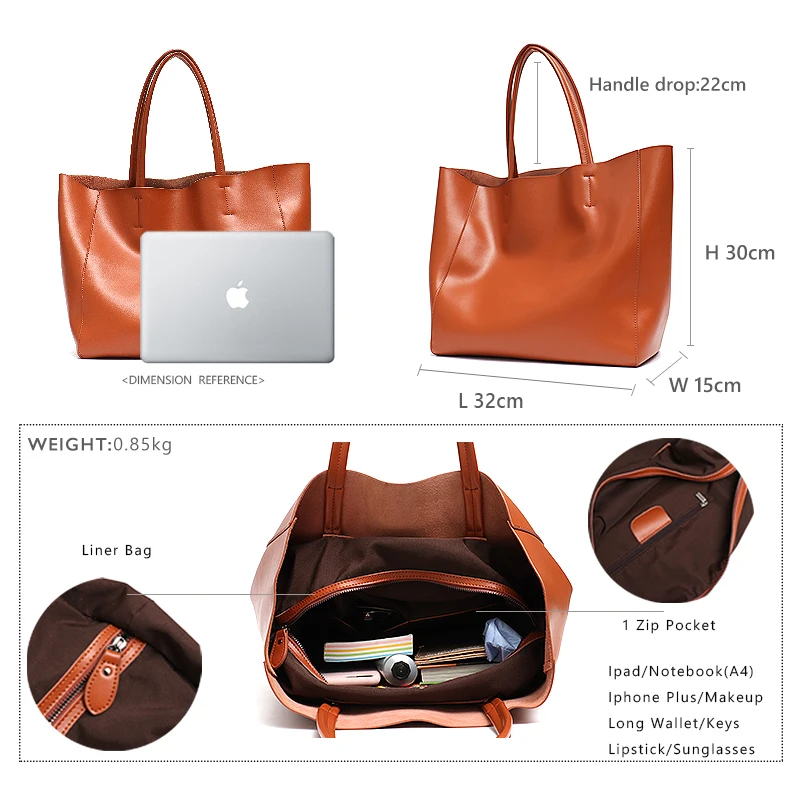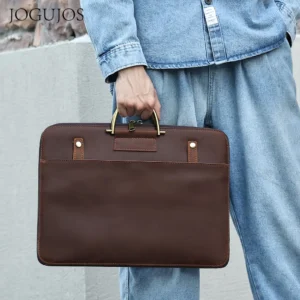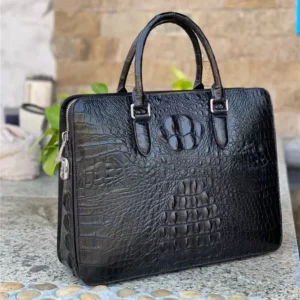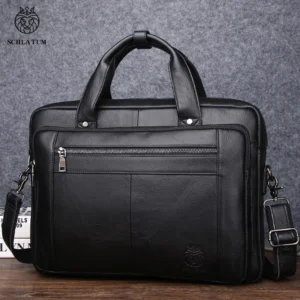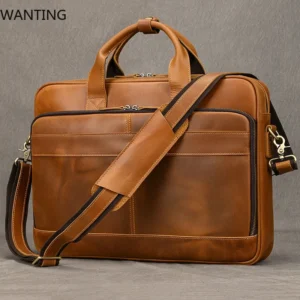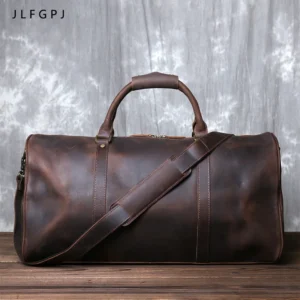Understanding Leather’s Natural Structure: The Foundation of Quality
Leather begins its journey as animal hide, most commonly from cattle. To truly grasp the difference between leather types, we need to understand the natural structure of this remarkable material. Animal hide isn’t uniform throughout—it consists of several distinct layers that each contribute different properties.
The cross-section of leather reveals its complex structure:
- Grain layer – The outermost surface with tightly packed fibers (this is where both full-grain and top-grain come from)
- Corium/dermis – The middle section with more loosely arranged fibers
- Flesh side – The innermost layer that was attached to the animal’s body
What makes the grain layer so special is its density and strength. This top quarter of the hide contains the most tightly woven fibers, creating natural resistance to moisture, abrasion, and wear. The way this grain layer is treated during processing is precisely what differentiates full-grain from top-grain leather.
Understanding these structural differences is crucial when choosing a timeless classic leather briefcase that will withstand daily use while maintaining its appearance.
Full-Grain Leather: Nature’s Premium Offering
Full-grain leather represents the pinnacle of leather quality. It’s created by using the hide’s outermost layer with its natural surface completely intact. The manufacturing process is intentionally minimal—the hide is cleaned, the hair removed, and the skin tanned, but the natural grain remains undisturbed.
This preservation of nature’s design results in several distinctive characteristics:
- Natural appearance – Full-grain leather proudly displays all the animal’s natural markings, including minor scars, wrinkles, and variations in texture
- Superior strength – By preserving the densest fiber structure intact, full-grain offers unmatched tensile strength and durability
- Breathability – Natural pores remain open, allowing moisture to evaporate and preventing bacterial growth
- Patina development – Perhaps its most celebrated quality, full-grain leather develops a rich patina over time, becoming more beautiful as it ages
- Evolving texture – Initially firm, full-grain leather gradually softens and conforms to use while maintaining structural integrity
Full-grain leather items can last for decades or even generations when properly maintained. The natural markings that some might consider “imperfections” actually tell the story of the animal’s life and make each piece uniquely authentic. This distinctive quality is readily apparent in our full-grain messenger bag collection, where each piece showcases leather’s natural beauty.
Top-Grain Leather: Engineered for Consistency
Top-grain leather represents the second-highest quality grade in the leather hierarchy. Unlike full-grain, top-grain undergoes a refinement process specifically designed to create uniformity. Manufacturers sand or buff away the outermost layer (approximately 0.04-0.08 inches or 1-2mm) to remove natural imperfections, then apply finishes to create a more consistent surface.
This processing results in distinctive characteristics:
- Uniform appearance – The sanding and finishing create a smooth, consistent surface without natural markings
- Good durability – While some strength is sacrificed by removing the outermost fibers, top-grain remains durable for most applications
- Limited breathability – The applied finishing coats (often including polyurethane) seal many of the natural pores
- Minimal patina – Top-grain develops less character over time as the natural surface has been altered
- Initial softness – The processing typically results in leather that’s more flexible and soft from the beginning
Top-grain leather is commonly found in luxury car upholstery and designer bags where a uniform appearance is desired. The protective coatings applied during finishing help resist stains and moisture, making it easier to maintain in certain environments.
When defining the best leather briefcases, understanding these processing differences helps explain why top-grain offers a good balance between quality, appearance, and price for many consumers.
Side-by-Side Comparison: Full-Grain vs. Top-Grain
To help you better understand the key differences between these premium leather types, here’s a comprehensive comparison of their essential characteristics:
| Characteristic | Full-Grain Leather | Top-Grain Leather |
|---|---|---|
| Source/Layer | Complete top layer with natural surface intact | Top layer with surface sanded/buffed |
| Appearance | Natural variations, visible markings | Uniform, consistent surface |
| Natural Markings | Present (scars, wrinkles, growth marks) | Removed during processing |
| Durability | Exceptional (can last decades or generations) | Very good (typically 5-10 years with heavy use) |
| Breathability | Excellent (natural pores remain open) | Limited (many pores sealed by finishing) |
| Aging/Patina | Develops rich, distinctive patina | Minimal patina development |
| Initial Texture | Firmer, gradually softens with use | Softer and more flexible from the start |
| Stain Resistance | Natural resistance, shows marks more easily | Enhanced resistance from protective coatings |
| Manufacturing | Minimal processing, cleaning and tanning | Sanding, buffing, correcting, coating |
| Complexity | Less processed, more natural | More processing steps required |
| General Cost | Premium price point | Moderate to high price point |
When choosing the perfect leather briefcase, these differences become particularly important. The right choice ultimately depends on your personal preferences regarding appearance, durability, and how you want your leather to age over time.
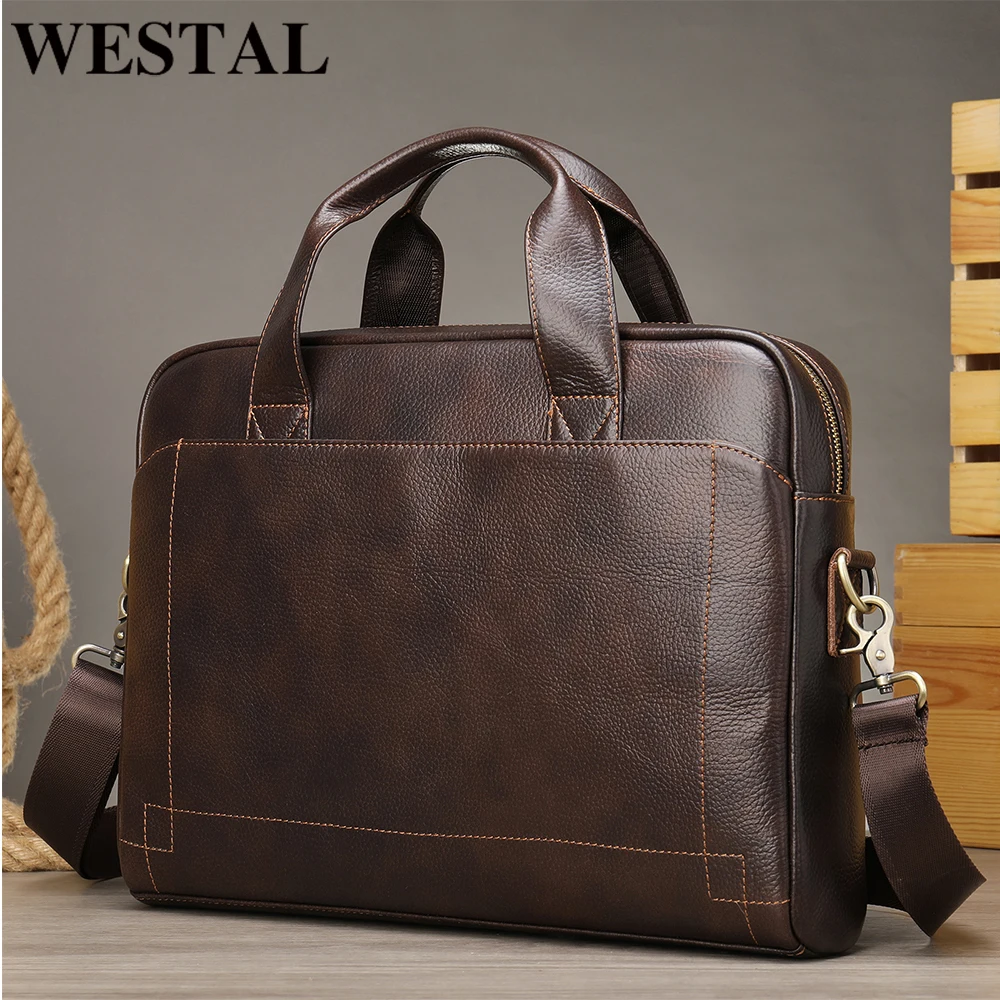
The Critical Factors That Matter Most
Fiber Integrity and Durability
The single most important difference between these leather types lies in fiber integrity. Full-grain leather preserves the hide’s outermost fibers—the most densely packed and strongest part. These intact fibers create a natural barrier against wear, moisture, and damage. Top-grain removes some of this natural protection, sacrificing some durability for aesthetic consistency.
Lifespan and Long-Term Value
Full-grain leather typically lasts 20+ years with proper care, often becoming family heirlooms. Top-grain leather, while still durable, generally has a shorter lifespan of 5-10 years with heavy use before showing significant wear. This lifespan difference directly impacts long-term value—full-grain’s higher initial cost often represents better value when calculated over decades of use.
Aesthetic Character vs. Uniformity
The visual difference centers on character versus consistency. Full-grain embraces natural imperfections—stretch marks, insect bites, and growth patterns that tell the hide’s story. Top-grain offers a cleaner, more uniform appearance with consistent coloring throughout. Neither is inherently “better”—it’s about whether you value unique character or refined consistency.
The Patina Process
Perhaps the most celebrated aspect of full-grain leather is its ability to develop patina—a warm, rich luster that develops through exposure to natural oils, sunlight, and handling. This gradual transformation creates a depth and character that many leather enthusiasts prize. Top-grain, with its altered surface and protective coatings, develops significantly less patina over time.
Breathability and Comfort
Full-grain leather’s natural porosity allows moisture to evaporate, reducing bacterial growth and providing greater comfort in items worn against the skin. Top-grain’s sealed surface limits this breathability, which can be noticeable in items like shoes or furniture where comfort during extended contact matters.
Price Factors
The price difference reflects several factors: full-grain requires more selective hide sourcing (only using hides with minimal natural defects), yields less usable material per hide, and demands more skilled craftsmanship to work with its natural variations. These factors explain why full-grain typically commands a 20-50% premium over comparable top-grain products.
For a deeper look at the durability advantages, our guide to the benefits of full-grain leather bags explores how these material differences impact everyday performance.
How to Identify Genuine Full-Grain and Top-Grain Leather
Visual Inspection
- Full-grain leather: Look for natural variations in texture, visible pores of different sizes, and subtle imperfections like small scars or wrinkles
- Top-grain leather: Appears more uniform with consistent coloration and texture; surface feels smoother with fewer visible natural markings
Touch Test
- Full-grain leather: Initially firmer with a natural, slightly textured feel that softens over time
- Top-grain leather: Often softer from the beginning with a smoother surface; may have a subtle synthetic feel if heavily coated
Edge Examination
- Full-grain leather: Cut edges reveal fibrous structure with variations in density
- Top-grain leather: Edges appear more uniform and may show evidence of coloring throughout
Natural Pore Identification
- Full-grain leather: Natural pores visible under close inspection, appearing in irregular patterns
- Top-grain leather: Pores may be less visible or appear more uniform due to surface treatments
Price Consideration
- Full-grain leather: Typically 20-50% more expensive than comparable top-grain items
- Top-grain leather: More affordable while still representing a quality leather option
These identification methods will help you make informed choices when seeking the ideal leather briefcase that meets your quality expectations.
Ideal Applications: Where Each Leather Type Excels
Full-Grain Leather Best Uses
- Heirloom furniture – Pieces meant to last generations and develop character
- Quality boots and footwear – Where durability and breathability matter most
- Premium briefcases and bags – Professional items that improve with age
- Belts and functional accessories – Items subjected to regular stress and strain
- Heritage and traditional goods – Where authentic character and aging are valued
Top-Grain Leather Best Uses
- Fashion-forward accessories – Where consistent appearance is prioritized
- Automotive upholstery – Requiring uniform appearance and good stain resistance
- Affordable quality furniture – Balancing durability with cost-effectiveness
- Hospitality and commercial settings – Where maintenance and uniform appearance matter
- Modern design applications – Where cleaner, more consistent aesthetics are desired
Full-grain dominates in applications where longevity and developing character are priorities. Top-grain excels when consistent appearance and easier maintenance take precedence. Our collection of classic leather briefcases showcases how these different leather types perform in professional applications.
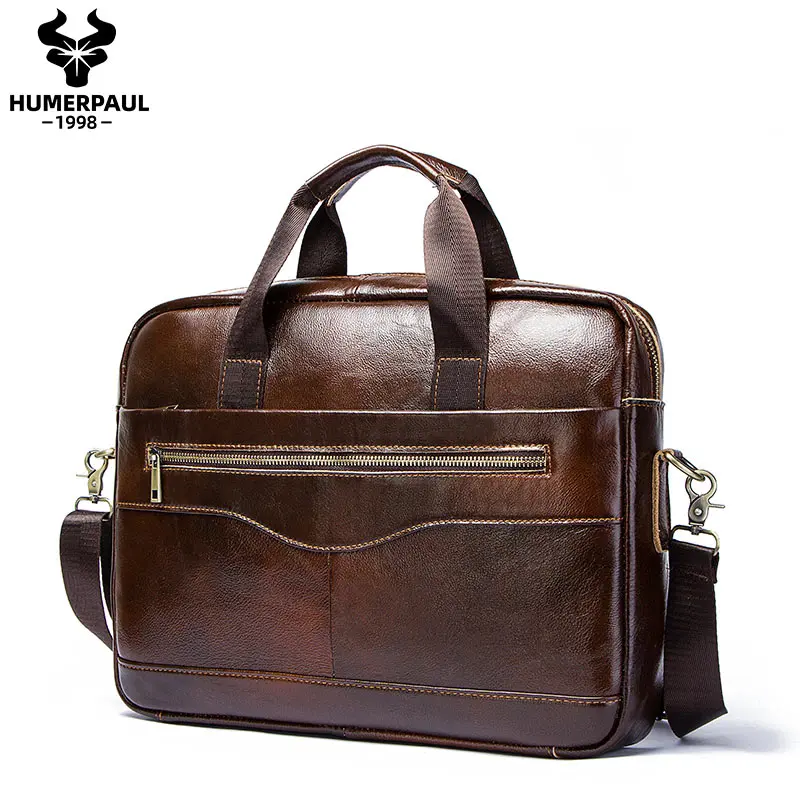
Pros and Cons: Making Your Decision
Full-Grain Leather Advantages
- Exceptional durability with potential to last decades or generations
- Develops unique patina and character that improves with age
- Superior breathability prevents moisture buildup and odors
- Natural markings create one-of-a-kind pieces
- Highest tensile strength and puncture resistance
Full-Grain Leather Disadvantages
- Higher initial cost (typically 20-50% more than top-grain)
- More susceptible to showing stains and marks
- Often requires more maintenance to preserve quality
- Initial stiffness may require breaking in
- Natural imperfections may be considered unattractive by some
Top-Grain Leather Advantages
- More affordable while still offering good quality
- Consistent, uniform appearance without natural marks
- Better resistance to stains and moisture
- Softer and more flexible from the beginning
- Requires less maintenance than full-grain
Top-Grain Leather Disadvantages
- Shorter lifespan due to removed strongest fibers
- Limited or no patina development
- Reduced breathability can cause comfort issues
- Lacks the unique character that many leather enthusiasts appreciate
- May look more artificial as it ages
For specific information about how these differences affect long-term performance, our article on top-grain leather briefcase durability provides real-world insights.
Beyond the Basics: Other “Leather Grades” to Be Aware Of
While focusing on full-grain and top-grain leather, it’s important to recognize other common terms you’ll encounter in the marketplace:
Genuine Leather – Despite its authentic-sounding name, “genuine leather” typically indicates a lower quality than both full-grain and top-grain. It’s made from the layers remaining after the top portions are used for better grades. While still real leather, it lacks the durability and character of higher grades.
Bonded Leather – This is the “particle board” of leather products, containing only 10-20% leather fibers mixed with binding agents and applied to a backing. While inexpensive, it typically deteriorates quickly and doesn’t offer the benefits of true leather.
Split Leather – Created from the lower layers of the hide after the top grain is removed, split leather is less durable but still useful for suede and applications where surface appearance is less critical.
Understanding these distinctions helps prevent confusion when exploring options like our leather document bag collection, where quality variations would be particularly noticeable.
Making Your Choice: Personal Factors to Consider
Choosing between full-grain and top-grain leather should ultimately reflect your personal priorities:
Budget Considerations
- What is your initial budget constraint?
- Are you looking for long-term value or lower upfront cost?
- How important is longevity in your purchasing decision?
Aesthetic Preferences
- Do you prefer natural character and unique variations?
- Is consistency and uniformity more appealing to you?
- Does the concept of leather developing a patina excite you?
Usage Patterns
- How frequently will you use the leather item?
- Will it be exposed to harsh conditions or elements?
- Are you looking for an heirloom piece or something more temporary?
Maintenance Willingness
- How much time are you willing to invest in leather care?
- Do you enjoy the process of maintaining quality materials?
- Would you prefer something more “set and forget”?
Both full-grain and top-grain represent quality choices—neither is universally “better” for everyone. A professional who values uniqueness and heritage might prefer full-grain for their everyday classic men’s leather briefcase, while someone prioritizing consistent appearance might find top-grain more suitable.
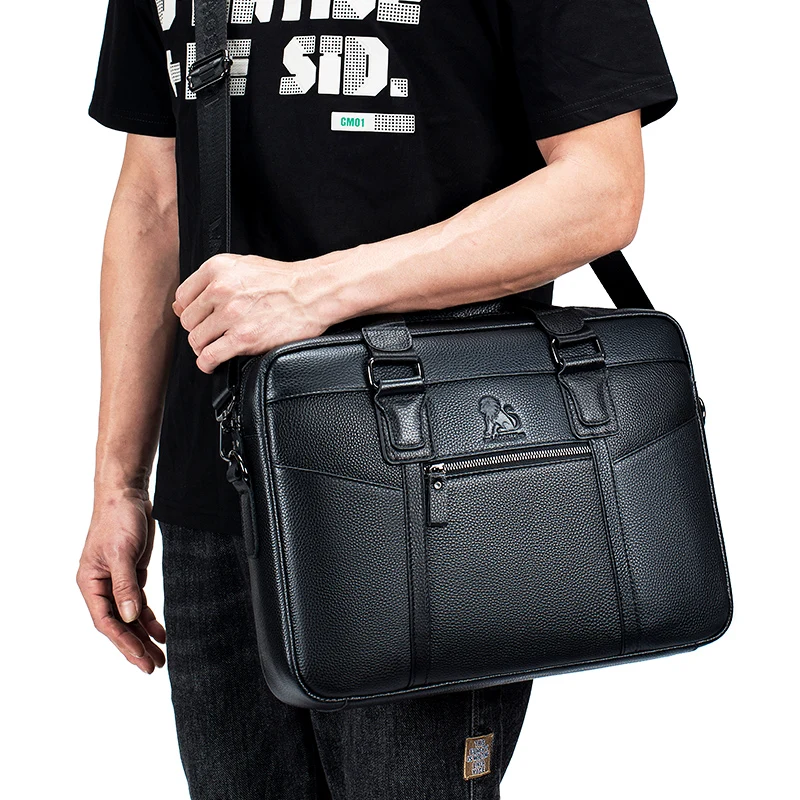
Men's Classic Leather Briefcase, Slim Leather Laptop Briefcase, Slim Leather Portfolio Briefcase
$93.67 Select options This product has multiple variants. The options may be chosen on the product pageClassic Laptop Briefcase, Men's Classic Leather Briefcase, Slim Leather Attache Case
Price range: $353.50 through $360.81 Select options This product has multiple variants. The options may be chosen on the product pageBlack Leather Briefcase, Leather Document Bag, Men's Classic Leather Briefcase
Genuine Crocodile Leather Executive Briefcase with Password Lock – Premium Business Document Carrier$1,201.87 Select options This product has multiple variants. The options may be chosen on the product pageBlack Leather Briefcase, Classic Laptop Briefcase, Men's Classic Leather Briefcase, Slim Leather Laptop Briefcase
$228.72 Select options This product has multiple variants. The options may be chosen on the product pageBrown Leather Briefcase, Classic Laptop Briefcase, Crazy Horse Leather Satchel, Men's Classic Leather Briefcase
Price range: $172.15 through $200.02 Select options This product has multiple variants. The options may be chosen on the product pageCrazy Horse Leather Satchel, Full Grain Messenger Bag, Men's Leather Satchel
$430.41 Select options This product has multiple variants. The options may be chosen on the product page
Caring for Your Leather Investment
Full-Grain Leather Care
- Clean with a slightly damp cloth and mild leather soap as needed
- Condition every 3-6 months depending on use and environment
- Allow natural darkening and patina development
- Store in breathable covers away from direct sunlight when not in use
Top-Grain Leather Care
- Wipe clean with appropriate leather cleaners
- Condition less frequently (every 6-12 months) but don’t skip it
- Use protectants designed for finished leathers
- Keep away from excessive heat sources
General Leather Care Guidelines
- Avoid direct heat sources including radiators and hair dryers
- Clean spills promptly but gently
- Never use harsh household cleaners or solvents
- Allow wet leather to dry naturally at room temperature
Proper care dramatically extends the life of both leather types. For comprehensive maintenance guidance, our article on mastering leather care for daily use offers detailed techniques specific to different leather qualities.
The Leather Legacy: Investment Value Beyond Price
Understanding the fundamental differences between full-grain and top-grain leather empowers you to make choices aligned with your values and needs. Quality leather transcends being merely a material—it becomes part of your daily experience, aging alongside you and developing character that synthetic alternatives cannot match.
The choice between full-grain and top-grain represents a personal philosophy about consumption: investing in exceptional durability and natural aging, or prioritizing consistency and lower maintenance. Both paths offer their rewards.
At Poise Porter, we believe that understanding these differences allows you to make choices that reflect not just your aesthetic preferences, but also your approach to quality and sustainability. A well-chosen leather item does more than serve its function—it becomes more personally valuable over time, especially evident in our collection of brown leather briefcases that showcase how quality leather enhances professional presence.
The true value of quality leather lies not just in what it is today, but in what it becomes tomorrow—a companion on your professional journey that improves with every use.

